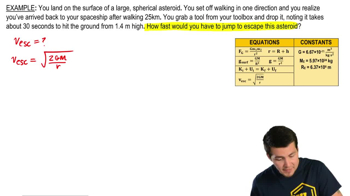Escape Velocity definitions Flashcards
 Back
BackEscape Velocity definitions
1/15
Terms in this set (15)
- Escape VelocityMinimum speed needed for an object to break free from a celestial body's gravitational pull without returning.
- Gravitational ForceAttractive force between two masses, decreasing with increased distance.
- Kinetic EnergyEnergy possessed by an object due to its motion, calculated as 1/2 m v^2.
- Gravitational Potential EnergyEnergy due to an object's position in a gravitational field, approaching zero as distance increases.
- Conservation of EnergyPrinciple stating total energy in a closed system remains constant, used to derive escape velocity.
- Gravitational ConstantUniversal constant (G) used in the calculation of gravitational forces and escape velocity.
- MassQuantity of matter in a body, affecting gravitational force but not escape velocity.
- DistanceInitial separation from a celestial body's center, influencing the required escape velocity.
- VelocitySpeed of an object in a specific direction, crucial for determining escape velocity.
- Final VelocitySpeed of an object when it reaches an infinitely distant point, ideally zero for escape velocity.
- Celestial BodyNatural object in space, such as a planet or star, from which escape velocity is calculated.
- Orbital DistanceAverage distance from a planet to the sun, used in escape velocity calculations.
- Square RootMathematical operation used in the escape velocity formula to solve for speed.
- Non-conservative ForcesForces like friction that do work on a system, not present in escape velocity calculations.
- Launch SpeedInitial speed required to achieve escape velocity, ensuring the object does not return.


